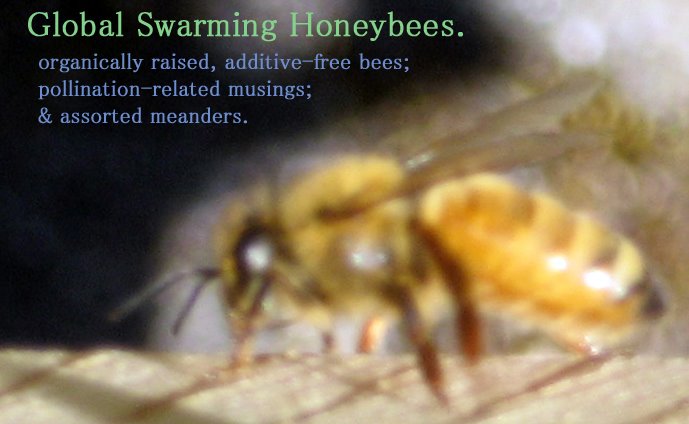Bee Culture just sent out the following announcement, entitled, Finally, A Complete Description Of Colony Collapse Disorder Across Time and Location. I'm reprinting it below in the hope that some of the info may be useful to beekeepers—though admittedly, a lot of this rehashes ground we've already covered in the past.
Jerry Bromenshenk has been involved with Colony Collapse Disorder from the very beginning. He and his colleagues at the University of Montana, the U.S Army’s Edgewood Chemical and Biological Center, his own company called Bee Alert Technology, and BVS, Inc. have ferreted out an amazing amount of information on this Disorder and are close to understanding the answers to this problem. Because of their work the beekeeping community i s more aware of the best management practices over time to combat the worst of the regular pests and diseases bees have, and this year the almond orchards should have an ample supply of bees for pollination, in part due to their efforts, and of course the work of many other researchers and scientists. Of course it’s only late December and bees are fickle, fragile creatures…and in bee time, it’s a long way to February.
Over the two years that Colony Collapse Disorder has been a recognized problem, this group has probably visited more beeyards suffering from CCD, in more locations, and over a longer a time than most of the people involved in this search. As a result, in a full report prepared by this team to be released in the February issue of Bee Culture magazine, Bee Alert’s Scott Debnam and Jerry Bromenshenk from Missoula Montana, David Westerveld from Florida’s Apiary Inspections Bureau, and Randy Oliver, a commercial beekeeper with significant honey bee research experience from Grass Valley, California detail the symptoms of CCD with respect to where it hits, and when it hits. This information is critical in making a diagnosis as symptoms do change as seasons progress and knowing what to look for and when to look for it is absolutely necessary in making correct decisions. So far, no better guidelines exist for diagnosing this disorder.
To review what’s commonly known:
The symptoms of the final stages of CCD have been oft repeated:
In collapsed colonies
· Complete absence of older adult bees in colonies, with few or no dead bees in the colony, on the bottom board, in front of the colony, or in the beeyard.
· Presence of capped brood in colonies during time of year when queen should be laying.
· Presence of food stores, both honey and pollen, unless a drought or time of year restricts availability of food resources.
· Absence of pest insects such as wax moth and hive beetle.
· Lack of robbing by other bees
· Robbing and return of hive pests is delayed by days or weeks.
In collapsing colonies
· Too few worker bees to maintain brood that is present.
· Remaining bee population predominately young bees.
· Queen is present.
· Queen may lay more eggs than can be maintained by workers, or is appropriate for the time of year.
· Cluster is reluctant to consume supplemental food such as sugar syrup and pollen supplement.
However, these are the terminal symptoms. By the time colonies reach this point it is far too late to do anything but bury the dead. Being able to spot colonies that are just becoming affected is a real plus because beekeepers can turn them around most times and keep them productive. Even though they still don’t know the cause, proper and appropriate management techniques go a long way in helping. Here’s what the team has found:
One year out:
Colonies are “just not doing well” with few other visible symptoms. They seem healthy, but have lackluster honey production.
Six months out:
Symptoms are vague and easily missed. Monthly inspections and careful comparisons are needed. Brood nests are slow to expand, with most in a single hive body. Mid-day inspections show bees dispersed in the colony, but this varies. Population growth slows to stops during growing season when compared to other colonies in the same yard. Honey stores remain untouched, bees are feeding on nectar recently collected. These symptoms are difficult to spot due to the careful comparisons needed.
Three months out:
CCD colonies appear slow to grow and are outpaced by non-CCD colonies in the apiary. There is a noticeable population decrease going from 3 to 2 boxes, or 2 to 1, and often the bees are on only a few frames in the bottom box…and they appear restless. Brood is shot gunned because of dead brood removal, and honey stores begin to diminish if it’s late in the season, but if early, the honey remains untouched. Routine maintenance goes undone and no propolis seals are noticeable.
One month out:
Usually 8 frames of bees or fewer remain and they decline rapidly. Brood is produced, but can’t be supported, queen replacement is often tried and abandoned brood is common. Stored honey depends on the season…in summer it may all be depleted, in winter untouched.
Finally:
Remaining bees fail to eat supplied food or medications, and it’s mostly young bees that remain now, as the older bees are gone. Queens continue to lay excessively, and the colony usually lacks any aggressiveness at all.
Visual Symptoms of a CCD Colony
Just days before its collapse the colony seemed to be strong and fully functional
Mostly young bees remaining in the hive
Bees are not aggressive
Queen is present
Eggs are present
Full frames of brood may be present
Brood may show signs of “shotgun” pattern
Capped honey and fresh nectar are often present, although not in summer collapses, which are uncommon
Fresh pollen has been stored in the hive recently, if external resources are available
Supplemental feed (syrup and extender patties) if supplied, are ignored
No robbing occurs
No secondary pests (small hive beetles, wax moths or ants) are found
No dead bees are noted around entrance of the hive
Bees do not show any signs of winglessness, paralysis or other adult bee diseases.
CCD tends to travel like a wave through a beeyard, and combining affected and unaffected colonies usually gives 2 dead colonies. Adding a package may help, and may not. There is a time until secondary pests will move in…using equipment before that time for more bees is risky and the colony may die again.
The Cause of Colony Collapse Disorder remains unknown, but the diagnosis, and thus the opportunity to administer remedial treatments is getting better all the time.
For the full article with additional information see the February issue of Bee Culture on our web site www.BeeCulture.com after Feb 1.
Thanks to Scott, David, Jerry and Randy.
This message brought to you by Bee Culture, The Magazine Of American Beekeeping



No comments:
Post a Comment